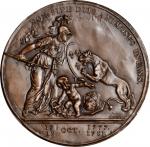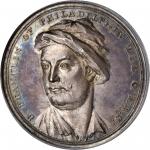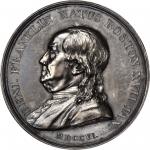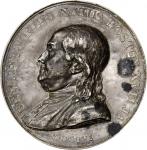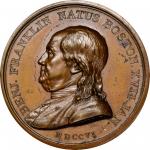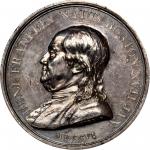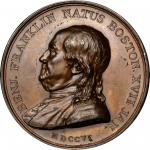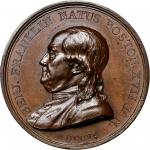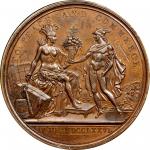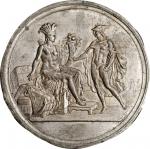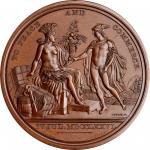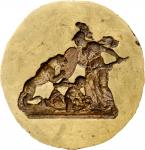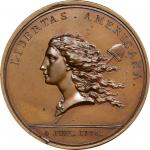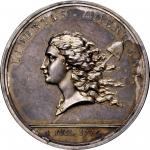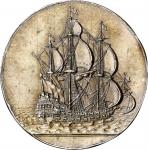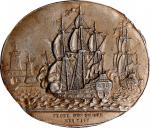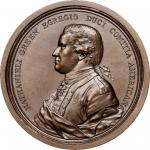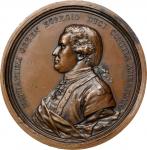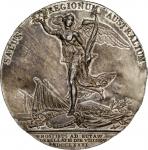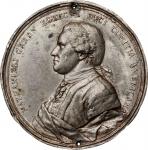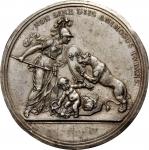1781 (Before January 23, 1783) Libertas Americana Medal reverse cliché. As Betts-615. White metal. Original. Workshop of Augustin Dupre. 47.0 x 46.8 mm., 214.0 grains. 0.5 - 1.5 mm thick. Choice About Uncirculated.Plain trimmed edge. Traces of paper fiber present on plain back. A superbly preserved soft metal impression, with only minor surface wear and most of the original paper still present on the blank back. Bright lustrous evidence of the tin beneath is visible at the peripheries of the unadorned back. The struck side is glossy and appealing, even dark gray with no major defects. Details are spectacularly sharp, including the cuirass on Minervas chest, an addition between the time the previous lot was made and when this one was struck. The face of Minerva appears more refined here as well.<p>This fascinating progress proof was made at a very particular moment of this dies journey to completion. The exergual legend is not present, though various raised scribe lines are visible in the exergue. The peripheral legend is the most interesting part of this pieces design, however: NON SINE DIIS ANIMOSUS INTANS - INTANS, rather than the correct spelling, INFANS. Fortunately, the person to whom Benjamin Franklin sent this cliche noticed: Alexandre-Theodore Brongniart, an architect and man of letters who was a vital link in the chain that connected Franklin with both the designer of the reverse, E.A. Gibelin, and medalist Augustin Dupre who brought the Libertas Americana medal to fruition.<p>On January 23, 1783, Brongniart wrote to Franklin:<p>"I have the honor of sending to Mr Franklin two new proofs of the medal, noting that the head is not quite as perfect as it should be, that the serpents held by the child will be larger and better drawn; moreover the engraver put intans instead of infans and this spelling mistake shall be corrected. <p>"I have the honor of reminding Mr Franklin that he had promised what he shall have inscribed on both sides at the bottom of the medal, and this matter alone prevents its completion."<p>Brongniart is acting as a go-between from Dupre, who produced this object, to Franklin, who commissioned it, all while serving as a vital critical eye. In a February 1785 to Franklin, Gibelin attests to Brogniarts role in his involvement: "the medal of the United States of America that you had struck last year (sic) was modeled after the design that I composed at the request of Monsieur Brongniart."<p>Not only was Brongniarts helpful edit of the legend corrected, but Dupre fixed his design flaws as well: on the final version, the lower of the two snakes has an additional coil at the end of its tail and the upper snake shows a forked tongue. Other improvements seen on the finished medal include the addition of DUPRE F. near the exergual line and the addition of a Gorgons head to Minervas cuirass.<p>Brongniart not only pointed out corrections - he even followed up to make sure they were received and executed. On January 31, 1783, he wrote to Franklin again:<p>"M. Brongniart has the honor of sending his respects to Mr. Franklin and begs him to let him know if he was given Friday of last week [i.e. the day after his previous letter was sent, January 24] two new proofs of the medal, and among others that of the head of Liberty. Mr Franklin has seemingly forgotten to send to Mr Brongniart what he wishes to have put at the bottom of the medal on each side, and this holds back the engraver who wishes to complete this work.<p>This confirms that Dupre also made cliches that, like this one, had no exergual legend, but with the correct form of the peripheral legend. No such cliches are known today.<p>As noted in the previous description, we know of just four Libertas Americana medal cliches, all of the reverse: this lot, the previous lot, Ford:288, and the framed and inscribed piece last sold in our 2012 ANA sale. We presume at least a few exist, if poorly documented, in institutional collections.<p>While every splasher has a great history, no trial piece for the Libertas Americana medal has so much direct documentary support as this one. When it was cataloged in our Ford sale, its major consequence was missed. Joined with the paper trail that fully explains it, this is an object of substantial historical importance.<p><strong>A Note On Trials: Cliches, Epreuves, and Splashers </strong><p><p>The Adams Collection of Comitia Americana and related medals is uniquely enriched by several specimens of a unique form of medallic production that is known by several different names. Typically struck from a die in its earliest state, usually before hardening, these trials were called epreuves - proofs - in the original French correspondence between Dupre and Duvivier and the Founding Fathers charged with the acquisition of the medals the Continental Congress authorized. In more modern numismatic literature, they are more often called cliches or splashers, the latter term being a fair description of just how these trials were made.<p>Unhardened dies are incredibly susceptible to damage, as 18th century die steel (and modern steel today) is brittle before it is hardened by quenching. Once a die is hardened, modification becomes very difficult, so if changes need to be made, they need to be done in that fragile, unhardened state. Engravers in major mints - Paris especially - were accustomed to making soft metal impressions as something of a proofreading copy, enabling the negative die to be viewed in the positive in rough draft form. Wax impressions were liable to leave bits of wax in the interstices of design elements, thus engravers settled upon tin (usually called "white metal" in modern numismatic circles) as the best medium.<p><p>Tin melts at 450 degrees Fahrenheit, a low enough melting point to be accomplished in any small workshop. A ladle full of molten tin poured onto a surface will cool and harden fairly quickly, but remain soft long enough that a die can be easily pushed into it by hand, leaving a relatively durable impression in medal. Most often, medalists would find a piece of scrap paper - a note, a newspaper, a book page - to pour the tin atop, thus preventing their workspace from getting scorched and making the tin sheet somewhat easier to lift and trim. <p><p>These splashers were not intended to be medals, or even permanent, but simply a temporary way to display the state of the die in the positive before its devices were rendered immovable. Each was personally crafted by the engraver in his shop. In the case of the Comitia Americana medals, the epreuves made by Duvivier, Dupre, and Gatteaux were ultimately intended to be viewed and handled by themselves and those close to the process. Benjamin Franklin reviewed the epreuves of the De Fleury medal between April 20 and May 4, 1780, then made recommendations regarding the lettering in the obverse exergue that were adopted by Duvivier. He later did the same with his Libertas Americana medal, correcting a spelling error on the reverse. Engraver Augustin Dupre retained many of his splashers in his personal collection, some of which found their way into institutions in France and the United States, some of which are in the present sale.<p><p>Thomas Jefferson used cliches as a spendthrift (and lightweight) way to collect all the medals of the Comitia Americana series, assembling a set for himself and another for his Virginia countryman James Madison. As he was preparing to depart Paris in September 1789, he wrote to Madison to let him know of the boxes he was shipping, including a box of books and several crates full of Houdons John Paul Jones busts that the sitter wanted to have distributed in America. <p><p><em>I have put a collection of the proofs in tin of the medals voted by the U. S. (except two, of which the dies are in America) the medals themselves not being allowed to be taken, I desired the workmen to let me have two sets of their last proofs; for their manner is, as their work proceeds, to make impressions of it in pure tin, in order to correct &c. These proofs are in fact more delicate than the medals themselves, and the last of them shew the impressions complete. I have had them arranged in a frame, under glass &c. & beg your acceptance of them.</em><p><p>By "delicate," Jefferson did not mean fragile, but well-detailed. The modern whereabouts of these sets are unknown; it is very possible that some proportion of either of these sets are in the current sale.<p><p>Jeffersons set left Monticello in February 1798 in the hands of an enslaved man named York, who Jeffersons son-in-law and overseer, the abusive drunkard Thomas Mann Randolph, called "allmost (sic) an idiot." Randolph told Jefferson that the thief had confessed, listing off an inventory of items from Jeffersons chambers including "some impressions in lead & tin of Dies of the Medals & Coins." He continued "I have some hope of recovering the proofs of Medals (tis from the description I conclude they are out) I have traced one to a Negroe of the neighbourhood who bt. it of York but he says he has lost it." The historical record on the theft and recovery thereafter falls silent; Jefferson wrote several consecutive letters to Randolph after the receipt of this letter but never acknowledged the incident. Two different men named York were enslaved by Jefferson concurrently, one of whom was inherited from the estate of Jeffersons father-in-law in 1774 and described as a "Waterman," the other of whom was born in 1781 and labored at Monticello. Presumably the York involved here was the latter of these two, aged 17 at the time of his act of resistance against Jeffersons authority.<p><p>Today, cliches of each of the Comitia Americana medals are extremely rare, with populations in the low single digits. There is not a single issue in this format that is known to the extent of 8 or 10 pieces. Matched sets of obverse and reverse are the exception rather than the rule. Each of the survivors is an accident, a piece that was made to serve a purpose at a moment in time, not produced for long-term preservation in a cabinet. Their historicity is exceptional, as each survivor was not only in the hands of the medals engraver, but likely in the hands of Thomas Jefferson, Benjamin Franklin, David Humphreys, or a small number of others. Their rarity surpasses that of their normally struck cognates in nearly every circumstance.<p><p>With the possible exception of the Charles Senter Collection, sold at auction in 1933, no cabinet has ever included such a wide array of these historic rarities as the John Adams Collection.<p><strong>The Libertas Americana Medal</strong><p>There is almost nothing we can say about the Libertas Americana medal that has not been said before. It is the most recognizable early American medal, the unanimous choice as #1 in the <em>100 Greatest Medals and Tokens book,</em> and the inspiration for many of the United States coinage designs of the 18th century. It is legendary beyond its rarity, historic beyond its celebrated creation narrative, and important far beyond the world of numismatics.<p>While not properly a part of the Comitia Americana series - it was a medal authorized by Benjamin Franklin as an individual, not the Continental Congress - the Libertas Americana medal has been adopted into this group ever since Thomas Jefferson saw fit to place one in George Washingtons set of Comitia Americana medals in the summer of 1789. By that time, the medal was several years old, as it had been completed and distributed by Franklin in the spring of 1783. Franklin sent his medal far and wide, in France, in the United States, and beyond. His postal accounts show that in April 1783 he twice hired a carriage to special deliver his medal to its recipient. Jefferson had one on display at Monticello, inventoried as "a medal by Dr. Franklin." The Dutch artist Johann-Georg Holtzhey had a friend write to John Adams to ask how he and his friends could obtain one. As the medals found their homes in April and May 1783, Franklins mailbox filled up with thank you notes from across the continent. On April 15 of that year, Franklin sent a bundle of them to Philadelphia to hand out to the members of Congress, including a silver one for Congress president, future Mint Director Elias Boudinot. <p>In September 1783, Franklin wrote to Boudinot "I am happy that both the Device and Workmanship of the Medal are approvd with you, as they have the good Fortune to be by the best Judges on this side the Water. It has been esteemd a well-timed as well as a well-merited Compliment here, and has had good Effects. Since the two first which you mention as received, I have sent by different Opportunities so many as that every Member of Congress might have One. I hope they are come safe to hand by this time." Boudinot confirmed their arrival and described how he parceled them out: "I have received the additional number of Medals, which, not having any particular directions from you, I distributed among the Members of Congress, presented one to the Governor of each State, and the Ministers round Congress."<p>Every Libertas Americana medal was once handled by Franklin, every great American and Frenchman of the era knew about the medal and associated it with Franklin, and every Libertas Americana medal surviving today has a remarkably historic provenance, whether it is fully documented or not.<p>The quoted descriptions of the medal come from the explication published in France in May 1783, quite possibly written by Franklin himself. This explication was printed as a leaflet and intended to accompany the medal itself.<p><strong>Obverse:</strong> "The Head representing American Liberty has its tresses floating in the air, to shew that she is in activity. The Cap carried on a Spear is her Ensign. The Date underneath is that of the Declaration of Independence."<p><strong>Reverse: </strong>"The United States of America are represented by an Infant Hercules, cradled in a Buckler to shew that they are nursed in War. A Leopard, representing England, comes with two serpents to destroy the Infant. France represented by a Minerva, comes armed to his succour, and under her protection he strangles the two serpents, while she guards him from the Leopard, by her shield marked with Fleurs-de-Lis. The Legend is a line of Horace, importing that the Infant was not without divine assistance. The Dates below are those of the two Capitulations of Saratoga & York-Town, whereby two entire English Armies that had enterd and ravaged the United States with fire & sword, were extinguished." In Franklins symbolism, this depiction recalls Hera, the stepmother of Hercules, releasing two snakes to kill Hercules in his cradle; those two snakes were the armies of Burgoyne (defeated at Saratoga) and Cornwallis (defeated at Yorktown).<p><p><p>From the John W. Adams Collection. Acquired from our 2012 ANA sale, August 2012, lot 4094. Earlier, from Augustin Dupre to Alexandre-Theodore Brongniart to Benjamin Franklin on January 23, 1783; Wayte Raymond; and our (Stacks) sale of the John J. Ford, Jr. Collection, Part XIV, May 2006, lot 286.

